The idea behind my project was that it would be accessible only for the people who notice it. I placed the envelopes at the University Center in various locations. The first time not many people engaged with the project because it was not easily noticeable. Based on the feedback I got last week during our class I developed the project further. The envelopes were too little to attract people, so I glued them onto sheets of red paper. The color red catches the eye and I hope that this time people will engage with this project.
I was going to make new, bigger envelopes, but at the very last moment I decided not to do so. The reason for that is that I still wanted the project to have something from the original idea. The envelopes were small as I wanted people to get curious about what’s inside. There is something mysterious about little envelopes hanging on the wall. They carry a special message. I had no doubt that I needed to make them more visible and after hours of brainstorming with my roommates, I came up with the idea to glue the envelopes on bigger sheets of paper. I think that the color red makes them pop out on any background and because of that they are visible.
The last step was to document the project in the actual space. I used my point and shoot camera to take the photographs. The colors are little distorted, which creates this funky mood. I chose spaces with colorful walls and many students to make sure that this time the envelopes are going to be noticed. After documentation part I took them down as I’m leaving tomorrow and I was afraid that someone was going to take them, as it happened before.
1.We prioritize a design’s impact on a community over the intentions of the designer.
I tried to satisfy this principle by bringing as little of my intentions as possible. However now that I think about it my project is based on an assumption that Social Justice Hub wants more members. Based on my observations and conversations I had with my friends on campus I concluded that SJH is not easily accessible, some people don’t know the purpose it serves and where it’s located. But it might not be so, in which case I did not satisfy this principle and let my intentions and assumptions get in the way.
2.The strongest solutions happen through the process, not in a moment at the end of the process. Thus it is important to us to open up the design process to those who will be most impacted by its outcomes.*
I haven’t contacted any of the members of SJH by myself. However during our class I got helpful feedback from one of the members. I used it to develop this project.
3.We use design to dismantle structures that marginalize, dehumanize, subjugate, and oppress others while centralizing voices that are most marginalized by institutional racism, patriarchy, and colonization.
This principle seems to resonate with my project most. Because we were designing for Social Justice Hub, the idea to centralize the voices that are most marginalized was very close to the mission of SJH. I became conscious of the fact that I’m designing not only for the SJH but also for the people who don’t know about this place and are looking for a safe space. I hope that this project will reach the people in need of an inclusive group.
4.We are reimagining the role of a designer as that of a creative facilitator rather than a creative expert.
I think I satisfied this principle. I don’t feel like an expert or in no way am I an authority. I was just trying to help in my own small way.
5.We believe in innate human brilliance. Everyone has the capacity to contribute in unique ways to design processes, and all people are experts in their own experiences.
I used some of my experience in the process of creation but I also learned from my classmates and their ideas and visions.
6.We undertake in processes that are transparent and accessible, that are led by the needs of the community, and that result in community ownership of the outcomes.
This is a principle that I hope I have executed. While designing I had the needs of the community in mind at all times. And my second hope is that SJH could actually benefit from this project.
7.We are not just creating new solutions — we are looking for ways to adapt what is already working in other contexts as well as reviving ancient approaches that have been erased by colonialism and capitalism.
I adapted materials such as old books to create something new from. The use of technology was limited to printing. In the second part of the assignment I adapted the pre-existing concept and materials to create something more visible.
8.We use design processes not just to address problems linked to various forms of injustice, but to build community, to heal, to experience joy, and to bring our visions of the future to life.
The goal behind this project was to inform about SJH in order to build a community, so I think this principle was fulfilled.
9.We share design knowledge and demystify technologies.
I think this one is not applicable to my process.
10.We are finding low-resource, non-extractive solutions that enhance our connection to the earth.
I used recycled paper, from old books and magazines to create this project. I believe in sustainability and I tried to incorporate that in the process of making.






